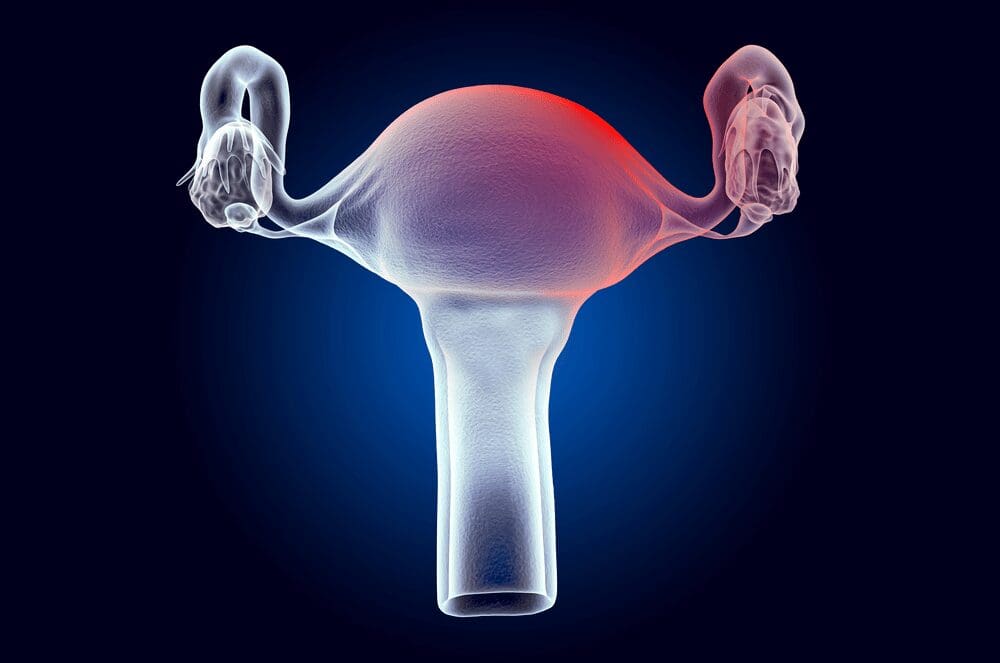Treatment options for adenomyosis used to be severely limited, but our team at North Texas Fibroids in Dallas, Cedar Hill, and Flower Mound, TX, can offer patients an alternative if they don’t want to go through a hysterectomy.
What Is the Best Treatment for Adenomyosis?
Uterine Fibroid Embolization Can Help
If you’ve been diagnosed with adenomyosis, trying to find the right treatment can be overwhelming. Our team offers uterine fibroid embolization as a treatment option for this oftentimes painful condition.
It’s a minimally-invasive treatment and can provide lasting relief for patients whose symptoms are getting in the way of them living their life to the fullest. Uterine fibroid embolization, or UFE, can be interchangeably referred to as uterine artery embolization.
How Does It Work?
From Consultation to Treatment
An Interventional Radiologist has specialized training when it comes to carrying out minimally invasive treatments like this. The experience and knowledge that will help us determine if this treatment is the right fit for you will also allow us to carry out the treatment quickly and effectively.
After a consultation, if you decide this is the treatment you’d like to pursue, we can set up an appointment. The treatment itself can usually be completed within an hour. First, the femoral artery will receive a small incision so we can guide a catheter through it.
The Use of Embolic Material
With the help of x-ray equipment, we will use this artery as a pathway to the blood supply that’s feeding your excess or misplaced uterine tissue. Once we’ve found that “food supply” we will block it with embolic material.
These little spheres will stay where they’re put, so you should continue to see an improvement in symptoms over time. We usually carry out this treatment on either side of the uterus to make sure you get the best possible results, and we can generally do this through the same small incision.
After Treatment
Once the treatment is done, we’ll use a vascular closure device to seal up the incision. We’ll watch you for a little bit before sending you home with discharge instructions. Of course, in addition to these instructions, we welcome any questions you have throughout the process. Our team is determined to make the entire experience as easy and comfortable as possible for each of our patients.
After about a week, we’ll have you back for a visit to check how you’re doing. Your final check-up will be about three months after treatment.
Symptoms of Adenomyosis
Heavy Menstrual Bleeding
This condition can make the unpleasant experience of a period downright miserable. Some women suffer silently with heavy periods, unaware that their cycle is abnormal. In addition, women with heavy bleeding may find themselves completely exhausted during their period, or even anemic.
Heavy Bleeding Can Be More Than an Annoyance
Working with a heavy period can be very challenging. Women with light or moderate bleeding can usually get by with either a pad or tampon, but heavy bleeders may need both to make sure they’re covered. To make matters worse, they may find their tampons and pads becoming saturated quickly, which means they’re having to change them out in the bathroom every few hours, hoping that no drops of blood make it onto their work clothes.
In severe cases, some women may not be able to work at all during the heaviest days, or may find themselves having to work from home. If your heavy periods are affecting your comfort, welfare, or your ability to work, it may be time to look into your treatment options.
Large Blood Clots During Your Period
It should be almost indiscernible when you pass a menstrual clot. If you are passing clots larger than a quarter, that qualifies as heavy bleeding. Large clots can be an especially problematic culprit of saturating pads too quickly.
Severe or Lengthy Cramps
This condition can make menstrual cramps have more length and intensity than they should. Some women have cramps so severe that painkillers barely take the edge off. Not only is this obviously distressing, but it can really get in the way of anything you want or need to do when your cramps are at their worst.
Pain During Sex
This condition can cause some discomfort, or at times outright pain, during sex. During a time when you want to be bonding with your significant other, you don’t want to be interrupted by pain.
The pain may be reduced by changing positions, but other times the uterine sensitivity caused by this condition can be enough to dissuade women from seeking out sex at all. If you find your symptoms are negatively interfering with your love life, a lasting treatment option can help you reclaim your comfort.
Long Periods
Periods are supposed to last between three to seven days, so if your monthly cycle is taking up more than a week, that is considered a heavy period.
Abdominal Sensitivity
This condition may make areas of your abdomen or pelvis tender and sensitive. It can also cause moments of sharp, shooting pain.
Spotting Between Periods
When your period’s over, you want to be able to put the pads and tampons back on the shelf and forget about it until next month. Unfortunately, that isn’t always possible. This symptom can cause bleeding randomly throughout the month, which can make some women wear a pad daily just to be safe.
Adenomyosis FAQ
1. What Causes This Condition?
The cause behind this condition isn’t clear, unfortunately. It may be more common in middle-aged women or women who have already given birth. It doesn’t always cause symptoms, so many women may have it and not even realize it.
2. How Is It Different From Endometriosis?
Both conditions involve the endometrial tissue and both can be pretty painful, so it’s hard sometimes to differentiate between the two. When it comes to symptoms, endometriosis isn’t as likely to cause heavy bleeding.
The tissue growth is also different between the two conditions. Tissue growth from endometriosis tends to spread farther. Sometimes tissue growth from endometriosis can end up on the fallopian tubes, bowel, pelvic sidewalls, or even the ovaries.
3. How Can It Be Diagnosed?
You can seek out a diagnosis through a pelvic exam, a transvaginal ultrasound, or other imaging scans such as an MRI.
4. Who Is a Good Candidate for UFE?
Patients Who Want to Avoid a Hysterectomy
When pain management isn’t working and you feel like you’ve exhausted your other options, you may be tempted to consider a hysterectomy. This can be an effective treatment option, but it’s a serious one that can come with a high price and lengthy recovery.
Even if you can afford the surgery, or your insurance is willing to cover it, taking the time off work that this surgery requires can be prohibitive. Having to spend a few days at the hospital can also be an unappealing prospect for many patients.
The Hysterectomy Process
Hysterectomies used to be considered the only lasting treatment option for adenomyosis, since removing the uterus should remove the painful symptoms associated with it. Since removing the ovaries would trigger immediate-early menopause, the ovaries are left in whenever possible.
There are several ways a hysterectomy can be carried out, which can include:
- Traditional hysterectomy
- Robot-assisted hysterectomy
- Vaginal hysterectomy
- Laparoscopic hysterectomy
UFE Can Help Women Avoid a Lengthy Recovery Period
While the recovery time after a hysterectomy can depend on your age as well as the type of hysterectomy you seek out, patients usually expect to wait six weeks before they can return to their normal activities. Depending on your lifestyle, this can be a very difficult task. Additionally, a hysterectomy can cause itching and bruise for some patients, and numbness in others.
Not Everyone Qualifies for a Hysterectomy
Some patients find that when they look into a hysterectomy they’re not a candidate for it. If you don’t qualify for a hysterectomy, a less invasive option like UFE may work instead. UFE can also be an alternative for women who just don’t want to have their uterus removed.
Whether or not you want to become pregnant in the future, losing a physical part of you can be a difficult process. Some patients consider their uterus to be an important part of their identity, even if it’s causing them pain. While a hysterectomy can be the right call sometimes, UFE can help many patients avoid the physical and emotional pain of a hysterectomy by providing an effective treatment that leaves their uterus intact.
Reach Out for a Consultation
Our team is extremely experienced when it comes to UFE treatments, and we can answer any question you want to ask about it. We want to help you find the right solution, and we thrive off of helping our patients improve their quality of life. Our office locations include Dallas, Cedar Hill, and Flower Mound, TX. Reach out to North Texas Fibroids today to set up your consultation!

